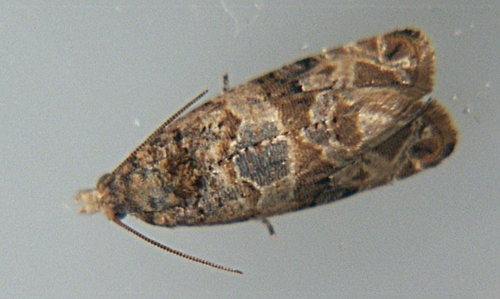European grapevine moth (aka European grape berry moth; (Lobesia botrana) was recently found in Napa County, a first known find for California. The insect has the potential to cause great economic harm to California’s diverse grape industries. The moth was trapped in Napa County’s, famous Oakville grape growing region known for high valued wines. Common to Europe and the Mediterranean, European grapevine moth has been intercepted from across the US where international travelers, cargo or mail disembark from planes originating from overseas. Currently, the Napa County Agriculture Commissioner is working with the CDFA and USDA to survey the area where the moth was first located in an attempt to detect additional European grapevine moths.
European grapevine moth identification
European grapevine moth can be confused with American grape berry moth (Endopiza viteana) native to the eastern United States or European grape berry moth (Eupoecilia ambiguella). Wings of the invasive European grapevine moth, L. botrana, have a mosaic shaped pattern with black-brown, cream, and gray-blue ornamentation (Fig. 1). Larvae tend to develop a purple cast after feeding and will often be found inside the berry. Samples should be taken to a trained university or state entomologist for proper identification and documentation. It is important to note that samples should be enclosed in a sealed container, jar, or vial if found prior to moving the insect (all stages) from an infested site.
Damage
Damage can be seen to both grape flowers and developing fruit. Larvae feed on flowers prior to bloom and continue through bloom. As bloom peaks, larvae protect themselves by producing webbing around the damaged flowers and feeding on neighboring flowers and parts. Second and third generation larvae feed on berries hollowing and contaminating them with excrements (Fig. 2). Cultivars that naturally have tight clusters—like Chardonnay, Pinot noir and Zinfandel—will suffer the most damage. Much like infestations from other worm pests, feeding damage will lead to infections by bunch rot fungi. Raisin and table grape cultivars will also experience damage, especially when bloom is prolonged due to weather, making flowers less responsive to applications of gibberellic acid used for bloom thinning. Table grape cultivars with tight clusters have the least tolerance for the moth due to fruit feeding damage and contamination with webbing, excrements and rot. All life stages can be found in vineyards infested with European grapevine moth but larvae from the second and third generations have been found to be the most damaging when fruit is maturing.
Host range
The host range for European grapevine moth is diverse. In addition to Vitis vinifera (cultivated grape), they also feed on other important agricultural crops like apple, cherry, nectarine, persimmon, plum, pomegranate and olive. It has been documented that privet and some grape cultivars are preferred for oviposition. Plants should be inspected for eggs, larvae and pupae. Larvae can be found in flower or fruit clusters along with webbing and in berries or other fruits. Pupae are frequently found inside a silken cocoon in rolled leaves, inside clusters, and under the bark of any of the previously mentioned host. At this time there are no regulations in place regarding the movement of fruit or other plant material from Napa County but growers and industry representatives should be vigilant. Trapping beginning at budbreak, using a tested pheromone is the best approach to monitoring vineyards for activity. Pheromones attract males to traps and allow one to estimate a population of European grapevine moth. With cooler fall temperatures, adult moths will be absent and only the diapausing pupal stage inside a silken cocoon can be found protected by grapevine bark. Growers should consult with their County Agriculture Commissioner or University of California personnel to determine the best approach to monitoring and properly identifying European grapevine moth.
Stephen Vasquez the UC Cooperative Extension viticulture farm advisor in Fresno County. Walt Bentley and Lucia Varela are UC IPM advisors in Fresno and Sonoma Counties, respectively.
Attached Images:

